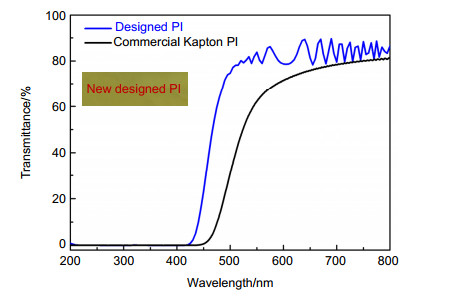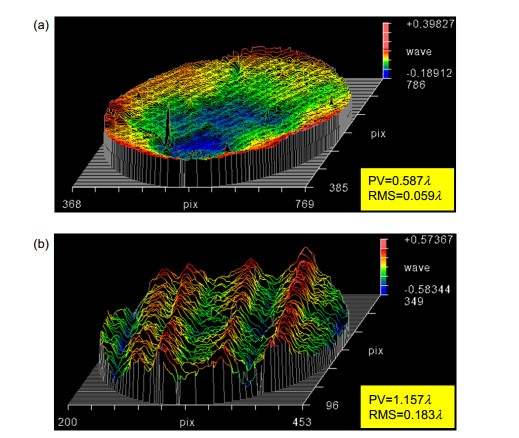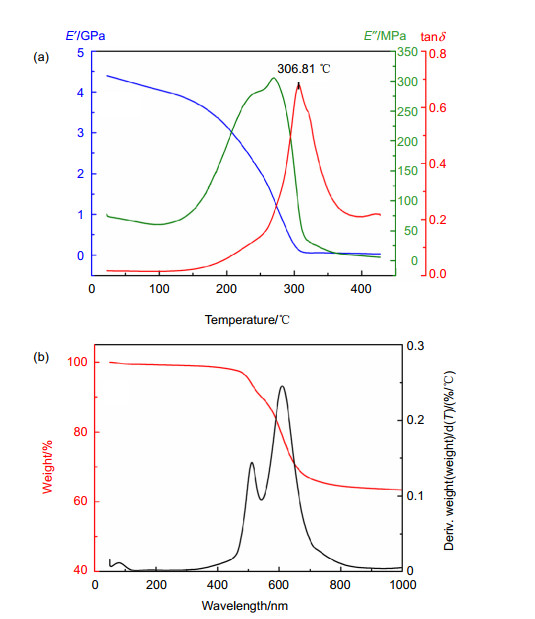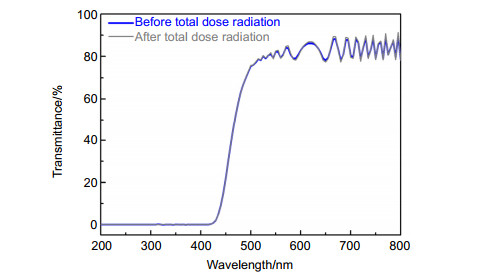High dimensional stability polyimide membrane material for space optical imaging system
-
摘要
空间光学成像系统采用薄膜主镜解决了大口径、轻量化、空间折叠展开等难题,但大口径光学透镜的成像指标要求高、空间应用环境恶劣,对透镜基底材料的性能要求严苛,其中尺寸稳定性、空间环境适应性尤为重要。本文提出在分子结构设计基础上,通过共聚合成的方法有效改性聚酰亚胺材料,通过在分子结构中同时引入刚性链和分子链间氢键作用,在保证传统聚酰亚胺高机械性能、高热稳定性的同时,改善其热尺寸稳定性、空间环境光学稳定性。所得高尺寸稳定性光学级聚酰亚胺薄膜材料综合性能良好,是优异的空间光学成像系统薄膜主镜候选材料。

Abstract
Polymer membranes are attractive mirror candidate for the space large aperture lightweight optical imaging system. But there are strict requirements for mirror material because of the harsh space application environment and the high optical imaging quality requirement. The dimensional stability is one of the most important prop-erties for optical mirror material. In this research, based on the molecular structure design, rigid molecular chain and hydrogen chain have been introduced to polyimide to improve the thermal dimensional stability. At the same time, the excellent mechanical, optical and thermal properties of the polyimide membrane have been guaranteed. The obtained optical grade polyimide has high dimensional stability, and the optical stability of the space environment and the excellent comprehensive properties are good candidates for the lightweight optical application.
-
Overview

Overview: Polyimides are a kind of high performance polymer with excellent chemical resistance, thermal stability, and mechanical properties. It is a good candidate material for building space large aperture lightweight optical imaging system. For example, to provide geosynchronous-orbit Earth observation capabilities the Membrane Optical Imager Real-time Exploitation(MOIRE) program, sponsored by the Defense Advanced Research Projects Agency (DARPA) seeks to further the technology development related to ultra light diffractive polyimide membrane-based telescopes. But there are strict requirements for the mirror material because of the harsh space application environment and the high optical imaging quality requirements. Under the space thermal alternation application environment, the temperature change can lead to deformation of the microstructure on the membrane, and then cause image distortion. A membrane optic is an optical system component with a large size, small thickness, and optical precision, so the membrane material and the manufacturing process are nontrivial. The dimensional stability and the optical homogeneity are two essential factors for large aperture optical mirror material. However, it's difficult for traditional aromatic PIs to simultaneously meet the challenging requirements of high dimensional stability, optical transmission, good thermal stability, and mechanical properties. Also it's hard to get large aperture PI films with good optical homogeneity based on the current membrane preparation process. In this research, based on the molecular structure design, rigid molecular chain and hydrogen chain have been introduced to polyimide to improve the dimensional stability and guarantee the excellent mechanical, optical, and thermal properties of the polyimide membrane. At the same time, by optimizing the membrane forming process, the wave-front error of the PI film can meet the requirements of optical use in diffractive imaging system. Compared with commercial Kapton polyimide membrane, the CTE of the new designed PI is ultra-low which is only -1.71×10-6/℃ in the temperature range of -150 ℃~100 ℃. Also, the tensile strength of the new designed PI is 200.6 MPa. The glass-transition temperature of it is 306.81 ℃. And the average transmittance of designed PI at 500 nm~800 nm is 82.9%. By optimize the membrane fabrication process parameters, the PV and RMS of Φ300 mm membrane can reach to 0.587λ/0.059λ(λ=632 nm). Also, the designed PI shows a good optical stability of the space environment. The obtained optical grade polyimide with high dimensional stability and good optical homogeneity. The excellent comprehensive properties is a good candidate for diffractive lightweight optical application. Also, it will be a good candidate for the optical system of many other fields like high power lasers and solar cells.
-

-
表 1 本研究制备的聚酰亚胺薄膜经过一定剂量真空紫外辐照和总剂量辐照前后在500 nm~800 nm波段范围内的平均透过率变化
Table 1. The average transmittance between 500 nm~800 nm of the new designed PI before and after a certain amount of the UV radiation and the total dose radiation
试验项目 T500 nm~800 nm辐照前 T500 nm~800 nm辐照后 紫外辐照/% 82.1 81.7 总剂量辐照/% 81.9 82.0 -
参考文献
[1] Kreuz J A, Edman J R. Polyimide films[J]. Adv Mater, 1998, 10(15): 1229-1232. doi: 10.1002/(SICI)1521-4095(199810)10:15<1229::AID-ADMA1229>3.0.CO;2-B
[2] Min K I, Lee T H, Park C P, et al. Monolithic and flexible polyimide film microreactors for organic microchemical applications fabricated by laser ablation[J]. Angew Chem, Int Ed, 2010, 49(39): 7063-7067. doi: 10.1002/anie.201002004
[3] Sekitani T, Zschieschang U, Klauk H, et al. Flexible organic transistors and circuits with extreme bending stability[J]. Nat Mater, 2010, 9(12): 1015-1022. doi: 10.1038/nmat2896
[4] Rubenchik A M, Parker J M, Beach R J, et al. Solar power beaming: From space to earth[R]. Livermore, CA: Lawrence Livermore National Laboratory, 2009.
[5] Hyde R A, Dixit S N, Weisberg A H, et al. Eyeglass: a very large aperture diffractive space telescope[J]. Proc SPIE, 2002, 4849: 28-39. doi: 10.1117/12.460420
[6] MacEwen H A, Breckinridge J B. Large diffractive/refractive apertures for space and airborne telescopes[J]. Proc SPIE, 2013, 8739: 873904. doi: 10.1117/12.2015457
[7] http://www.darpa.mil/news-events/2013-12-05, Membrane Optical Imager for Real Time Exploitation (MOIRE). aspx.
[8] 刘韬, 周一鸣, 王景泉, 等. 波带片衍射成像技术在对地观测卫星中的应用[J]. 航天器工程, 2012, 21(3): 88-95. https://www.cnki.com.cn/Article/CJFDTOTAL-HTGC201203019.htm
Liu T, Zhou Y M, Wang J Q, et al. Application of zone plate diffractive imaging technology in earth observation satellites[J]. Spacecr Eng, 2012, 21(3): 88-95. https://www.cnki.com.cn/Article/CJFDTOTAL-HTGC201203019.htm
[9] http://nexolvematerials.com/nexolve-products/low-and-zero-cte-polyimides
[10] Rossi M, Hessler T. Stray-light effects of diffractive beam-shaping elements in optical microsystems[J]. Appl Opt, 1999, 38(14): 3068-3076. doi: 10.1364/AO.38.003068
[11] Ando T, Korenaga T, Suzuki M A, et al. Diffraction light analysis method for a diffraction grating imaging lens[J]. Appl Opt, 2014, 53(11): 2532-2538. doi: 10.1364/AO.53.002532
[12] Zhang H, Liu H, Lu Z W, et al. Modified phase function model for kinoform lenses[J]. Appl Opt, 2008, 47(22): 4055-4060. doi: 10.1364/AO.47.004055
-
访问统计


 E-mail Alert
E-mail Alert RSS
RSS

 下载:
下载:











